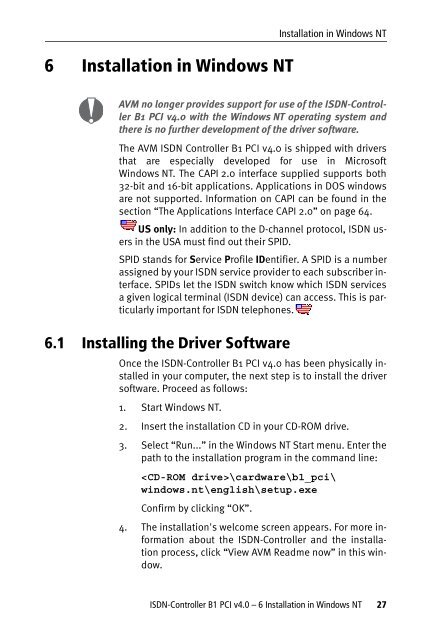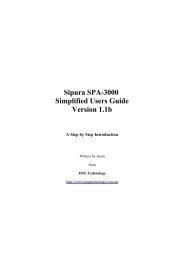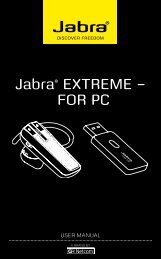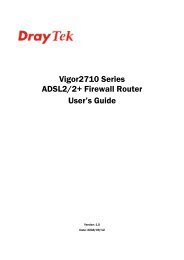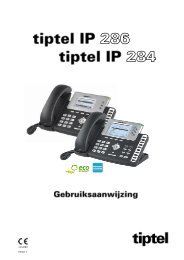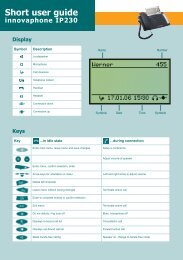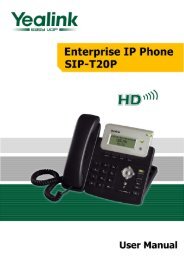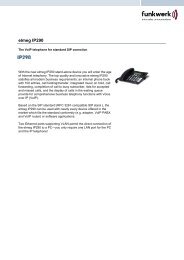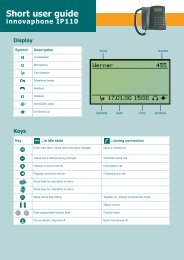1 The AVM ISDN-Controller B1 PCI v4.0 - VoipAndGo
1 The AVM ISDN-Controller B1 PCI v4.0 - VoipAndGo
1 The AVM ISDN-Controller B1 PCI v4.0 - VoipAndGo
Create successful ePaper yourself
Turn your PDF publications into a flip-book with our unique Google optimized e-Paper software.
6 Installation in Windows NT<br />
Installation in Windows NT<br />
<strong>AVM</strong> no longer provides support for use of the <strong>ISDN</strong>-<strong>Controller</strong><br />
<strong>B1</strong> <strong>PCI</strong> <strong>v4.0</strong> with the Windows NT operating system and<br />
there is no further development of the driver software.<br />
<strong>The</strong> <strong>AVM</strong> <strong>ISDN</strong> <strong>Controller</strong> <strong>B1</strong> <strong>PCI</strong> <strong>v4.0</strong> is shipped with drivers<br />
that are especially developed for use in Microsoft<br />
Windows NT. <strong>The</strong> CAPI 2.0 interface supplied supports both<br />
32-bit and 16-bit applications. Applications in DOS windows<br />
are not supported. Information on CAPI can be found in the<br />
section “<strong>The</strong> Applications Interface CAPI 2.0” on page 64.<br />
US only: In addition to the D-channel protocol, <strong>ISDN</strong> users<br />
in the USA must find out their SPID.<br />
SPID stands for Service Profile IDentifier. A SPID is a number<br />
assigned by your <strong>ISDN</strong> service provider to each subscriber interface.<br />
SPIDs let the <strong>ISDN</strong> switch know which <strong>ISDN</strong> services<br />
a given logical terminal (<strong>ISDN</strong> device) can access. This is particularly<br />
important for <strong>ISDN</strong> telephones.<br />
6.1 Installing the Driver Software<br />
Once the <strong>ISDN</strong>-<strong>Controller</strong> <strong>B1</strong> <strong>PCI</strong> <strong>v4.0</strong> has been physically installed<br />
in your computer, the next step is to install the driver<br />
software. Proceed as follows:<br />
1. Start Windows NT.<br />
2. Insert the installation CD in your CD-ROM drive.<br />
3. Select “Run...” in the Windows NT Start menu. Enter the<br />
path to the installation program in the command line:<br />
\cardware\b1_pci\<br />
windows.nt\english\setup.exe<br />
Confirm by clicking “OK”.<br />
4. <strong>The</strong> installation's welcome screen appears. For more information<br />
about the <strong>ISDN</strong>-<strong>Controller</strong> and the installation<br />
process, click “View <strong>AVM</strong> Readme now” in this window.<br />
<strong>ISDN</strong>-<strong>Controller</strong> <strong>B1</strong> <strong>PCI</strong> <strong>v4.0</strong> – 6 Installation in Windows NT 27


